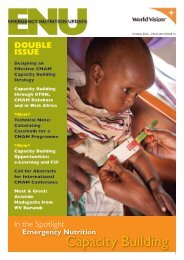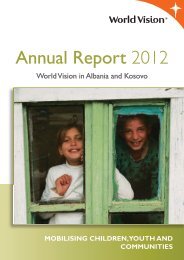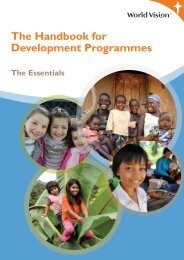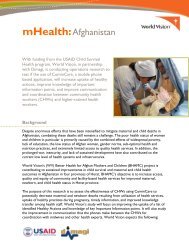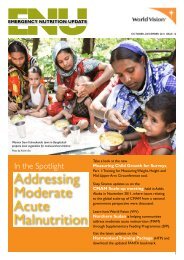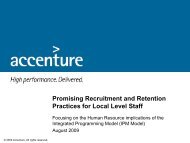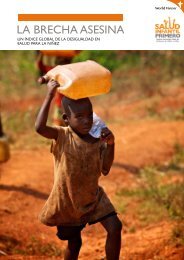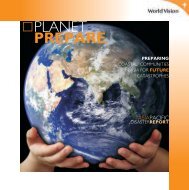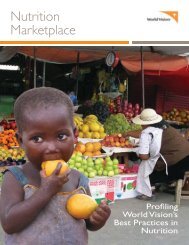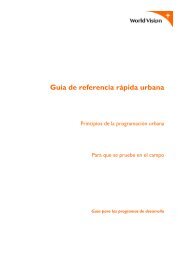Create successful ePaper yourself
Turn your PDF publications into a flip-book with our unique Google optimized e-Paper software.
The Post-2015 Agenda: Policy Brief #4<br />
Fragility and conflict<br />
in the post-2015 goals<br />
The issues at a glance<br />
• The Millennium Development Goals have been ineffective in contexts of conflict and fragility, causing<br />
1.5 billion people to miss a decade of concerted international action on poverty reduction.<br />
• Making new development goals relevant for fragile contexts will promote equity in development.<br />
• Targeting children and youth in a fragility-sensitive goals framework will stimulate intergenerational<br />
change.<br />
• New targets will drive public participation and government planning across all goals.<br />
• Though politically sensitive, a new goal promoting inclusive governance could target inclusion, justice<br />
and peace.<br />
Rationale<br />
The Millennium Development Goals (MDGs) have not<br />
been effective in fragile contexts, causing 1.5 billion<br />
people 1 to miss out on a decade of concerted<br />
international action on poverty reduction. Prioritising<br />
peacebuilding and statebuilding in a new set of<br />
development goals is a way to reach these most<br />
vulnerable and marginalised communities. World Vision<br />
argues that by targeting fragile contexts, the post-2015<br />
development goals can capture the pursuit of equity with<br />
the same clarity that the MDGs brought to the reduction<br />
of poverty. Targets that address inclusion, accountability<br />
and effectiveness could be added to each of the new<br />
goals. One further goal addressing inclusive governance<br />
could target social inclusion, justice and peace.<br />
Fragility and conflict embody the causes of the most<br />
acute inequity and vulnerability; and children are<br />
particularly vulnerable to the violence, neglect and abuse<br />
that arises. When Brazil, India and China are set aside,<br />
the majority of the undernourished, the impoverished<br />
and the uneducated people and the main proportion of<br />
infant deaths are in fragile and conflict-affected states. 2<br />
The 2011 World Development Report captured this<br />
situation in its declaration that no fragile or conflicted<br />
state will achieve a single MDG.<br />
Gaps in the MDG architecture<br />
The MDGs were effective in raising the priority of<br />
poverty reduction and are driving improvements in wellbeing<br />
for women and children. However, they have not<br />
proven effective at reaching hundreds of millions of the<br />
world’s most vulnerable people. This is evident when<br />
considered from the point of view of fragile and conflictaffected<br />
contexts, which embody the two biggest failings<br />
of the MDGs.<br />
First, the MDGs did not mandate an equity approach:<br />
many countries were able to claim success in reaching<br />
targets while leaving their hardest-to-reach people no<br />
better off. Second, for the least developed, most conflictaffected<br />
places the goals did not prioritise the<br />
fundamentals of peace, justice and inclusion that would<br />
enable them to achieve the other poverty targets. As the<br />
World Bank has noted, ‘Military-only, justice-only or<br />
development-only solutions will falter.’ 3<br />
Mother and children in drought-affected northern Somalia.<br />
Amanda Jepchirchir Koech/World Vision<br />
World Vision International Policy Brief on the Post-2015 development agenda: Number 4<br />
Page 1
Continued fragility has compromised the capacity of<br />
governments, communities and donors to reduce<br />
poverty, impacting the most vulnerable people,<br />
particularly children. Conflict-affected areas, in particular,<br />
are host to the most egregious abuses of children’s rights,<br />
as has been recognised in repeated resolutions of the UN<br />
Security Council and the establishment of the Watch List<br />
on Children and Armed Conflict. 4<br />
The MDGs have had unprecedented success in<br />
reaching most of the world’s poor, but in doing so they<br />
have passed over the world’s most poor. An enhanced set<br />
of goals must correct this, adding to the clear poverty<br />
focus of the MDGs a new emphasis on equity.<br />
‘Fostering development in conflict-affected<br />
states has become the development challenge<br />
of the 21 st century.’<br />
– UN System Task Team on the post-2015 UN Development<br />
Agenda (May 2012)<br />
Consideration of fragile contexts in the post-2015 goals is<br />
a critical pathway to achieve this.<br />
What has happened since 2000:<br />
Aid effectiveness<br />
The MDGs gave rise to a growing need to measure both<br />
the progress and the quality of development assistance.<br />
The resulting aid effectiveness movement has been the<br />
focus of mainstream development thinking since then,<br />
with successive agreements that have, at least in principle,<br />
rewritten the rules of conduct for international<br />
development. Significant outcomes include:<br />
• mandating much stronger coordination<br />
(harmonisation) between donors<br />
• giving developing states ownership of the<br />
development agenda for a more authentic<br />
partnership approach<br />
• avoiding donor-established parallel systems and<br />
policies in developing countries<br />
• paying attention to results and accountability<br />
• strengthening the role for civil society.<br />
Perhaps the most radical expression of this movement<br />
was at the 2011 Busan aid effectiveness conference, in<br />
launching the New Deal for Fragile States. The New Deal<br />
Fragile contexts<br />
Fragile contexts are those where a government<br />
cannot or will not act on its responsibility to<br />
protect and fulfil the rights of the majority of the<br />
population, particularly the poor. These<br />
responsibilities include territorial control,<br />
security, public resource management, service<br />
delivery and livelihood support.<br />
Fragility does not conform to state borders and<br />
relatively stable states may encompass fragile<br />
regions. Conversely, fragile states can contain<br />
zones of stability. Ultimately, basic accountability<br />
relationships between governments and citizens<br />
in fragile contexts are weak or broken.<br />
Many fragile states are post-conflict countries<br />
and are at high risk of relapse to conflict and the<br />
rise of criminal violence. Many also endure<br />
cyclical natural disasters. Conflict, violence and<br />
disaster have severe effects on economic<br />
growth, and so the most affected fragile contexts<br />
have growing levels of extreme poverty, which is<br />
counter to the trend in most low-income<br />
countries.<br />
gave voice to the world’s most fragile states, home to<br />
those who have missed out on the benefits of the MDGs<br />
and who characteristically have little say in development<br />
decisions affecting them.<br />
The New Deal process enables fragile states to use an<br />
assessment of their own fragility as the basis for<br />
negotiating new development compacts with the donor<br />
community. Significantly, the New Deal is built around<br />
the ‘Peacebuilding and Statebuilding Goals’ (PSGs, which<br />
are quite distinct from the MDGs):<br />
• Legitimate Politics – Foster inclusive political<br />
settlements and conflict resolution.<br />
• Security – Establish and strengthen people’s<br />
security.<br />
• Justice – Address injustices and increase people’s<br />
access to justice.<br />
• Economic Foundations – Generate employment<br />
and improve livelihoods.<br />
• Revenues and Services – Manage revenue and<br />
build capacity for accountable and fair service<br />
delivery.<br />
World Vision International Policy Brief on the Post-2015 development agenda: Number 4 Page 2
Of the five PSGs, the first three target a set of<br />
problems that are distinct from those addressed in the<br />
MDGs. The experience of the MDGs in fragile states<br />
suggests that it is the failure to deal with these first three<br />
issues that has blocked progress on the poverty goals.<br />
Universal fragility?<br />
There is a risk that some countries, those that reject<br />
being called fragile or those that are more stable, may<br />
ignore any set of perceived ‘fragility goals’. This outcome<br />
should be avoided as responding to fragility is intrinsic to<br />
the pursuit of equity in poverty reduction. Moreover<br />
many, possibly most, countries have elements of fragility<br />
within their borders, where there may be entrenched<br />
conflict, criminal violence, limited government access or<br />
legitimacy, disenfranchised citizens, extreme economic<br />
vulnerability and extremes of poverty. Gross abuses of<br />
children’s rights are more prevalent where government is<br />
weak, violence is widespread and social structures are<br />
shattered. Progress against the MDGs has bypassed these<br />
communities even in more successful developing<br />
countries. If these states disregard fragility targets,<br />
particularly for children and youth, then social, ethnic and<br />
geographical inequality may be perpetuated into the next<br />
generation.<br />
The peacebuilding NGO Saferworld has published an<br />
excellent analysis comparing the MDGs to several<br />
existing peacebuilding frameworks. 5 This shows a clear<br />
alignment between each of the peacebuilding frameworks<br />
(including the New Deal) but very little crossover with<br />
the MDGs. The analysis identifies a useful set of common<br />
values that are broadly similar to the PSGs (legitimacy,<br />
security, justice, livelihoods, revenues and services), but<br />
with two significant inclusions that articulate the role of<br />
social groups and the responsibility of the international<br />
community:<br />
• All social groups can participate in decisions<br />
that affect society.<br />
• The international community is effectively<br />
addressing the external stresses that lead to<br />
conflict.<br />
The importance of these two factors is emphasised in a<br />
new analysis of the aftermath of 15 recent civil wars. This<br />
report found that the single most common factor in<br />
preventing the resurgence of conflict was the inclusion of<br />
the full range of civil actors – including former opponents<br />
– in post-war governance. It recommends the continued<br />
involvement of the international community through the<br />
peace process, with the purpose of ensuring inclusion. 6<br />
Ensuring the inclusion of all social groups in the<br />
processes of governance is something that no country<br />
has fully achieved. Disenfranchisement happens in myriad<br />
ways, both overt and subtle. The effects of this may be<br />
the most extreme in fragile contexts, but inclusive<br />
governance is relevant for all states. The broad relevance<br />
of inclusive governance is also a challenge to its adoption<br />
as it challenges existing power structures.<br />
Promoting inclusion in fragile contexts is not without<br />
risk. Ill-informed or poorly designed civic empowerment<br />
can result in renewed conflict or violence, directed at<br />
children and women. This risk reinforces the need for<br />
participation by representative civil society groups in<br />
determining how inclusion is best approached. The New<br />
Deal for Fragile States offers one possible approach to<br />
this, by providing a state-sanctioned and donor-supported<br />
forum for civil society to participate in identifying drivers<br />
of fragility and setting appropriate goals and strategies for<br />
their context.<br />
Addressing conflict and fragility:<br />
Minimalist or radical change?<br />
For these reasons and also to preserve the clarity of the<br />
existing goals, it is not proposed to add several new goals<br />
to an existing MDG framework. In its first post-2015<br />
policy brief, World Vision has argued for a set of<br />
enhanced goals that build on the existing MDGs in order<br />
to ‘finish the job’ of poverty reduction and reach beyond<br />
it to assure equitable development opportunities for all. 7<br />
One of the criticisms of the MDGs is that they<br />
demand very little accountability of donor or recipient<br />
governments to ensure that their investment in<br />
development targets the MDGs. They can claim credit for<br />
the outcome without having to track how they got there.<br />
Building stronger accountability into each new or<br />
enhanced goal is one way to implement equity principles<br />
that apply equally to all countries and that can promote<br />
inclusion across all issues. This addition could address<br />
some of the particular concerns of fragile contexts but<br />
would not be sufficient. World Vision suggests that<br />
creating one specific goal on inclusive<br />
governance would capture the most essential parts of<br />
the peacebuilding and statebuilding agenda.<br />
World Vision International Policy Brief on the Post-2015 development agenda: Number 4 Page 3
Fragility additions to a post-2015 framework<br />
Existing MDG Themes<br />
Additional targets for each theme are:<br />
• government planning, budgeting and systems<br />
• public participation, including by children and<br />
youth, in target setting, planning and<br />
implementation.<br />
Revised International Partnership Goal<br />
Additional targets are:<br />
• donor accountability to support recipient country<br />
development planning<br />
• donor accountability in assuring civil participation<br />
• global cooperation for cross border influence.<br />
One New Goal: Inclusive Governance<br />
Includes targets on:<br />
• inclusion<br />
• justice<br />
• peace and the elimination of violence.<br />
This formulation differs from the approach suggested<br />
by the UN System Task Team (UNTT), which advocates<br />
a three-pillar structure encompassing peace and security;<br />
sustainable human development; and rights, law and<br />
justice. The UNTT suggestion has merit as it brings<br />
together three sometimes competing discourses, but it<br />
carries the risk that governments could ignore one of the<br />
pillars as not being relevant to them. WV’s proposed<br />
enhanced framework is a more integrated response that,<br />
by maintaining the focus on poverty reduction for the<br />
most vulnerable groups while emphasising equity and<br />
inclusion, makes it harder to pick and choose.<br />
Measurement<br />
An enhanced set of goals will bring new challenges for<br />
measuring progress. Beyond refined health, education and<br />
household income indicators, a new goal frame such as<br />
that proposed above would need to track factors such as<br />
government budget allocations, civic empowerment and<br />
opportunity, conflict levels, equity in access to justice and<br />
a range of donor actions, including donor alignment to<br />
the new framework.<br />
Civil society has experience in a number of these new<br />
areas, including collecting indicators disaggregated<br />
according to age, gender and other factors. World Vision<br />
and other organisations have developed various tools<br />
that measure government accountability in particular, and<br />
there is an entire discipline of peacebuilding and<br />
statebuilding monitoring that has not been part of the<br />
MDGs. The states, donors and civil society organisations<br />
collaborating on the New Deal for Fragile States are<br />
generating a set of ‘shared indicators’ to measure<br />
progress against the Peacebuilding and Statebuilding<br />
Goals that address many of the new components of this<br />
proposed revised framework.<br />
The shared indicators of the New Deal confront two<br />
of the challenges of measuring progress on issues of<br />
inclusion, accountability and peace. Unlike traditional<br />
poverty measures that rely on quantifiable indicators,<br />
progress on these new issues requires a blend<br />
of quantitative indicators (e.g. corruption indices, arrest<br />
rates, numbers of local conflicts resolved by peace<br />
agreement) and qualitative ones that measure<br />
perceptions of justice, security and accountability. Though<br />
this is new territory for a set of global goals, established<br />
mechanisms for collecting such information are being<br />
considered for the New Deal’s shared indicators.<br />
Bringing such initiatives to scale will be essential to the<br />
success of a new set of goals. In doing this, measurement<br />
initiatives that have been the domain of the nongovernment<br />
sector will become increasingly in demand.<br />
This will present two challenges: for civil society to share<br />
ownership of these initiatives and find ways to expand<br />
their use, and for governments and donors to avoid<br />
losing the strong civil participation values that underpin<br />
them. In short, measurement of the new goals will<br />
depend on genuine and lasting collaboration among<br />
donors, recipient countries and civil society. Such<br />
cooperation would itself be an indicator of progress in<br />
peacebuilding and statebuilding.<br />
Boy attends school in an IDP camp in Herat, Afghanistan<br />
Paul Bettings/World Vision<br />
World Vision International Policy Brief on the Post-2015 development agenda: Number 4 Page 4
Conclusion<br />
The post-2015 goals framework is a chance to promote<br />
equity in opportunities for development for all, most<br />
particularly for the world’s most vulnerable children living<br />
in fragile contexts. If they are to succeed, the new goals<br />
need to speak clearly to the governments of the world,<br />
to tell them that concerted action is possible and that it<br />
will have an impact. This was part of the genius of the<br />
original MDGs—that by naming the main obstacles to<br />
poverty reduction and setting clear and measurable<br />
targets for their achievement, the international aid<br />
community was able to work together in pursuit of them,<br />
with some success.<br />
Similarly, by naming governance, peace, participation<br />
and justice as the key challenges for equity in<br />
development for those living in fragile contexts, it may be<br />
that things that were previously thought to be beyond<br />
the reach of international cooperation will become<br />
another full part of the international development effort.<br />
Difficult, but essential. ‘What we measure shapes what<br />
we collectively strive to pursue’. 8<br />
Bringing these elements into a new set of goals is not<br />
revolutionary. The UN Millennium Declaration reminds<br />
us that they have long been recognised as essential to<br />
good development. The thinking and practice of the last<br />
decade has equipped us to act.<br />
World Vision’s recommendations<br />
1. Promote responses to fragility in an<br />
enhanced set of development goals as the<br />
surest pathway to equity in development.<br />
This will be achieved by:<br />
a. creating a goal on inclusive governance<br />
that targets inclusion, justice and peace<br />
b. adding targets on government<br />
planning, budgeting and systems, and<br />
on civil participation to the successors<br />
to the existing goals 1–7<br />
c. adding targets on donor accountability<br />
for civil participation and support for<br />
government planning, and on global<br />
cooperation on cross-border influences<br />
to the successor to the existing goal 8.<br />
2. Donors, governments and civil society<br />
organisations should begin to collaborate<br />
on shared approaches to participatory<br />
measurement of progress against the new<br />
goals.<br />
© World Vision International 2012<br />
1 World Bank, World Development Report 2011: Conflict, Security and<br />
Development (April 2011).<br />
2 Ibid.<br />
3 Ibid.<br />
4<br />
http://watchlist.org/the-issue/.<br />
5 Saferworld Briefing, ‘Approaching Post-2015 from a Peace Perspective’<br />
(September 2012).<br />
6<br />
Charles T. Call, Why Peace Fails: The Causes and Prevention of Civil War<br />
Recurrence (April 2012), Georgetown University Press, Washington DC.<br />
7 World Vision, The Post-2015 Agenda: Policy brief #1: Reaching the<br />
world’s most vulnerable children (November 2012), 2.<br />
8 Joseph E. Stiglitz, Amartya Sen and Jean-Paul Fitoussi, Report by the<br />
Commission on the Measurement of Economic Performance and Social<br />
Progress (2010) www.stiglitz-sen-fitoussi.fr. Quoted in the UN Thematic<br />
Think Piece on Peace and Security.<br />
World Vision International Policy Brief on the Post-2015 development agenda: Number 4 Page 5
CONTACTS<br />
World Vision Lead contact on Post-2015 agenda:<br />
Chris Derksen-Hiebert<br />
Director, External Relations, Advocacy and Justice for Children<br />
chris_derksen-hiebert@worldvision.ca<br />
Post-2015 Policy Briefs series editor: Kate Laburn Peart<br />
Director, Public Policy, Advocacy and Justice for Children<br />
World Vision International: Global Executive Office<br />
1 Roundwood Avenue, Stockley Park<br />
Uxbridge, Middlesex UB11 1FG<br />
United Kingdom<br />
+44.20.7758.2900<br />
World Vision International: Advocacy and Justice for Children<br />
World Vision House<br />
Opal Drive, Fox Milne<br />
Milton Keynes MK15 0ZR<br />
United Kingdom<br />
+44.1908.841.063<br />
World Vision International Liaison Office<br />
7-9 chemin de Balexert<br />
Case Postale 545<br />
CH-1219 Châtelaine<br />
Switzerland<br />
+41.22.798.4183<br />
World Vision International: United Nations Liaison Office<br />
919 2nd Avenue, 2nd Floor<br />
New York, NY 10017<br />
USA<br />
+1.212.355.1779<br />
World Vision Brussels & EU Representation ivzw<br />
18, Square de Meeûs<br />
1st Floor, Box 2<br />
B-1050 Brussels<br />
Belgium<br />
+32.2.230.1621<br />
www.wvi.org<br />
World Vision is a Christian relief, development and advocacy organisation dedicated to working with children, families and communities to<br />
overcome poverty and injustice. World Vision serves all people, regardless of religion, race, ethnicity or gender.



